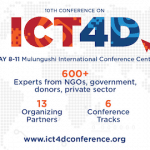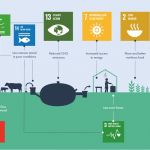Making ICT4D Green: Three Focus Areas for Improving the Environmental Impact of the Information and Communication Technology for Development Sector
The 10 warmest years since 1850 have all happened in the past decade, and 2023 was the hottest year on record. To combat the escalating climate crisis, many governments, businesses and development sector players are leveraging digital technologies, which have become essential tools for measuring and reducing carbon emissions, developing sustainable infrastructure, and providing early warnings of climate-related natural disasters, among other uses.
But while digital technology can and does play a role in climate change mitigation and adaptation — among its many other benefits — we cannot close our eyes to the impact the global digital transformation has on our climate and the broader environment. And the “Information and Communication Technology for Development (ICT4D)” or “tech for social good” sector should be no exception to this.
As we gear up for the 2024 ICT4D Conference — a key event in the discussion of global digital development — next month, it’s a good time to reflect on how the ICT industry can mitigate its climate and environmental impacts. Below, I’ll discuss the sector’s growing efforts to increase its sustainability, focusing on three key elements of ICT: generative AI, broadband access and electronic equipment.
The environmental impact of generative AI
The hype around generative AI is everywhere. And while many have raised valid concerns around bias, misinformation, privacy and data security, and intellectual property rights in the context of generative AI, development professionals have shown a strong interest in the potential of using this emerging tool to increase their impact.
However, there has been less discussion in the sector of the environmental impact of generative AI. Recent reports have suggested that it requires a tremendous amount of energy, stemming not only from the use of generative AI, but also from the training and updating of these models. According to an article by IT researchers Ajay Kumar and Tom Davenport in the Harvard Business Review in July 2023, “Training models are the most energy-intensive components of generative AI. Researchers have argued that training a ‘single large language deep learning model’ such as OpenAI’s GPT-4 or Google’s PaLM is estimated to use around 300 tons of CO2 — for comparison, the average person is responsible for creating around 5 tons of CO2 a year, though the average North American generates several times that amount.”
Generative AI requires so much energy that at a Bloomberg-hosted event at the World Economic Forum’s annual meeting in Davos, Switzerland last month, Sam Altman, CEO of OpenAI argued that the future development of artificial intelligence will require an energy breakthrough, since AI is consuming vastly more power than people expected. He believes that the emergence of more climate-friendly energy sources, like nuclear fusion and cheaper solar power, will be essential to AI’s ongoing development. “There’s no way to get there without a breakthrough,” he said. “It motivates us to go invest more in fusion.”
In the meantime, how can the development sector grapple with the climate and environmental impacts of its growing use of AI? “Do no harm” is a central pillar to any development and humanitarian work, and many organisations have extended this principle to apply to the carbon footprint of their activities. Should the use of generative AI become more ubiquitous in the sector, these organisations will need to reckon with its environmental costs as well. (There are also human costs to generative AI, which AI researcher Sasha Luccioni explored in an interesting article on Ars Technica last year.)
Fortunately, tech-focused researchers and analysts have already identified several ways in which the use of machine learning and generative AI can produce less emissions. To that end, the above-mentioned article by Ajay Kumar and Tom Davenport offers the following recommendations:
- Use existing large generative models, instead of creating your own.
- Fine-tune the training of existing models, instead of starting from scratch.
- Use energy-conserving computational methods like the TinyML framework.
- Use a large generative model only when it offers significant value.
- Be discerning about when you use AI, selecting other tools for less impactful tasks.
- Evaluate the energy sources of your cloud provider or data center, seeking those that avoid fossil fuels.
- Re-use models and resources, including open-source AI models.
- Include AI activity in your carbon monitoring, and publicise this data.
However the sector ultimately addresses the issue of generative AI’s environmental impact, it will have to start by learning more about this challenge and its potential solutions — which is why the topic will be part of the ICT4D Conference panel discussion on “Greening ICT4D.”
The carbon footprint of broadband internet
The availability of reliable connectivity greatly impacts the effectiveness of ICT4D, and in many locations where global development organisations work, there’s limited availability or choice of internet service providers. But while more people are gaining internet access in emerging economies — something that is generally seen as a positive development — there is a clear and growing environmental cost associated with it.
The data centers that support the near-instantaneous transfer of information around the world are famously electricity-hungry. But the carbon footprint of the internet is not generated solely by these data centers: It’s also generated by the infrastructure needed to enable the transmission of that data. For instance, laying fiber optic cables, including undersea cables, is a costly process. And it is made all the more expensive by the lack of interconnection junctions and public rights of way, and by redundancies in construction that can limit or outright restrict small actors and communities from participating.
There’s growing awareness of the environmental impact of global efforts to boost internet access — but progress in addressing this impact has been slow. The Alliance for Affordable Internet published a report in 2021 looking at the environmental implications of sustainable, universal access to the internet. Based on a review of national broadband plans from 100 low- and middle-income countries, the report notes that environmental themes are rarely mentioned in these documents, and that there’s a gap between words and action in these countries’ efforts to increase internet access in an environmentally positive way. It goes on to argue that we need to “recognise and reduce the carbon footprint of internet use so that we reach universal access without worsening the global climate emergency.”
To that end, the report suggests a number of policy recommendations for a greener internet. These include, among other things, investing in digital skills, e-government services and efforts to expand cost-sharing and innovative financing to support network and tower operators that use alternative energy sources.
The report also recommends increasing local content to create demand for greater internet use and thus share the environmental burden of broadband infrastructure more widely. This may seem counter-intuitive, since increasing the number of internet users creates further demand for relevant infrastructure, increasing the environmental impact. However, the report argues that “when we reframe this model to understand the environmental impacts of the internet on a per-user basis, the logic flips.” This is because much of the infrastructure to increase access to connectivity already exists, and access is limited due to socioeconomic barriers. As a result, “as more people come online, the carbon cost of the internet shared by each user shrinks.”
Minimising and recycling e-waste
A large part of any organisation’s ICT infrastructure is the equipment its teams use — mobile phones, computers, tablets, etc. That equipment suffers wear and needs replacement, but more significantly, most of it is not created to last. The average lifespan of a smartphone is approximately 2.5 years, and depending on the manufacturer, software and security updates may cease just two or three years after the device is first released. This results in a lot of e-waste.
Further compounding this problem, electronics have gone from being something a neighborhood shop could repair to being the exclusive domains of the manufacturers, with many companies requiring consumers to only use the manufacturer’s maintenance services, restricting access to tools and components, and imposing software barriers to prevent unauthorized repairs. But communities are increasingly fighting for the right to repair electronic devices, with laws in the U.S., the U.K. and India leading the way. Some manufacturers, such as Fairphone and Nokia, have also started producing repairable mobile devices. However, it will likely take some time before these types of phones enter global development organisations’ mobile device fleets.
Beyond the right to repair, another step towards a circular economy is IT equipment recycling. There are companies all over the world that take an organisation’s e-waste, clear its data and then work to refurbish, recycle or dispose of it safely. For example, Danoffice IT — a leading supplier of IT infrastructure to INGOs (including Catholic Relief Services, where I work as Senior Director of ICT4D) — now also offers recycling of used IT equipment.
These efforts face several challenges, such as the limited number of certified local facilities for equipment recycling in many of the countries where the development sector operates. Still, it seems organisations are waking up to the need to recycle their existing e-waste, and to invest in circular practices for new procurements.
What you can do today to make ICT4D greener
Much of the global effort to make ICT4D greener will require systemic change and planning. But if you work in a development-focused business or organisation, there are immediate steps you can take:
- Be selective in your use of generative AI and seek to minimise the environmental cost of using it.
- Help expand internet use to spread the burden of broadband infrastructure and optimise the use of existing infrastructure.
- Use utilities and suppliers that are leveraging renewable energy sources.
- Establish e-waste policies, and work with a certified IT equipment recycler to implement them.
And of course, you can also join us at the ICT4D Conference in Accra, Ghana, March 18-21, to discuss these and other related topics in more detail.
Nora Lindström is Senior Director of ICT4D at Catholic Relief Services.
Photo courtesy of jbdodane.
- Categories
- Energy, Environment, Technology, Telecommunications, WASH



